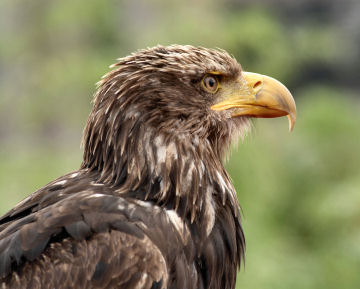Thieves of a feather
Some birds are masters of law-breaking. These corrupt species steal food from other birds—and commence away with it.
A diverse collection of birds is blameful of so much thievery, and scientists get long wondered what these families of birds have in common. A inexperienced study suggests that big organic structure sizing does not predict bullying deportment. Rather, among new traits, it is the sized of the birds' brains that matters most.
 |
| Golden eagles often steal food from other birds. Wish other plumelike thieves, these birds have big brains in relation to their overall size. |
| iStockphoto |
Food larceny is also called kleptoparasitism, and about 2 percent of the world's birds do it. That's 197 out of 9,672 known bird species that have been seen swiping food from other bird species.
Certain families of birds, including falcons, eagles, and pelicans, are especially inclined to larceny. Close to songbirds, on the past hand, are inferior likely to steal.
To learn more about what makes some birds tend toward a life of crime, scientists from the University of Québec at Montréal analyzed 856 published reports of theft by one bird from another.
Researcher Julie Morand-Ferron, a phallus of the study squad, says she started the project subsequently observance birds in Barbados sneak dry dog food out of unattended bowls. The birds, called Carib grackles, then snatched pellets from each other.
For her study, Morand-Ferron considered only birds that steal from other species of birds (rather than from dogs, people, or the thief's ain species). She record about some dramatic examples of thievery, including birds that grabbed food from others in midair and high-speed chases during which birds zigged and zagged through the sky. She learned that members of some species harass other birds until they spit up food that they'd swallowed.
The team found both patterns among the behaviors of the birds they studied. For one matter, bird families that often steal incline to live in open environments such as sea shores. There, they can easy consider the targets of their attacks.
Kleptoparasitic families also lean to consume angle, mice, and other vertebrates instead of antitrust insects. These meatier meals are hard to catch, and they deliver lots of valuable calories, thusly they are tempting to steal.
Finally, kleptoparasitic birds tend to take up big brains in intercourse to their bodies. That may seem surprising, since human bullies are frequently thought to be stronger in size than in smarts.
But for birds, theft isn't about creature strength. It takes a apt bird to get food out of another thirsty bird's claws, especially if that bird is bigger than you are. Put differently, birds that steal power deserve several respect.
"There's this stigma attached to individuals who steal things to make a living: that they can't catch Pisces the Fishes or forage on their own," says Saint David Shealer of Loras College in Dubuque, Hawkeye State.
But Shealer has studied birds named roseate terns. And the terns that steal, helium says, are "out and away the best parents."
But don't take this as advice to set about swiping cookies from your classmates' lunches. These are birds we're talking about!
Sledding Deeper:
Milius, Susan. 2007. Hatch a thief: Brains incline birds toward a life of crime. Science News program 172(Declination. 15):372. Available at http://World Wide Web.sciencenews.org/articles/20071215/fob3.asp .

0 Response to "Thieves of a feather"
Post a Comment